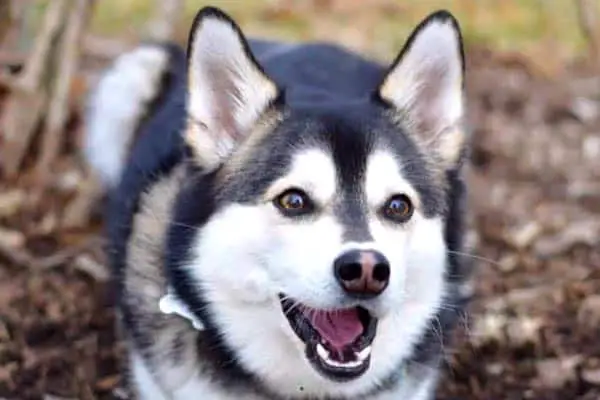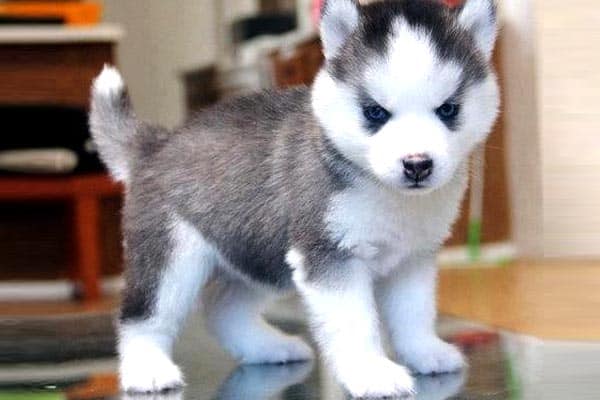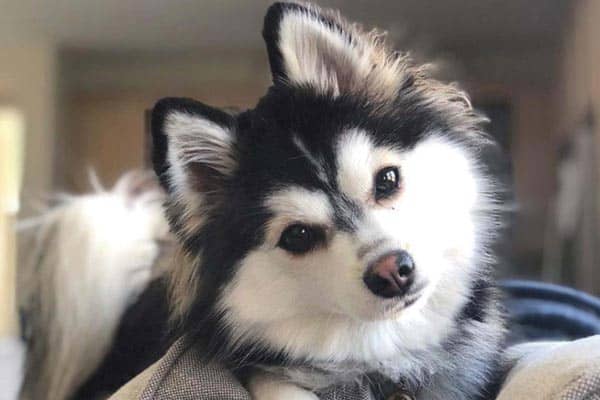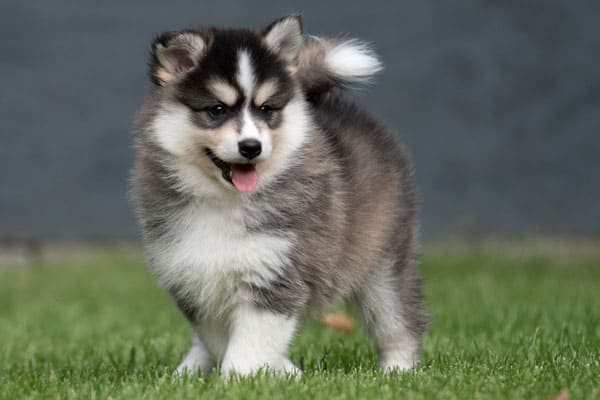Are Pomskies Easy to Train: the Best Training Tips You Need to Know
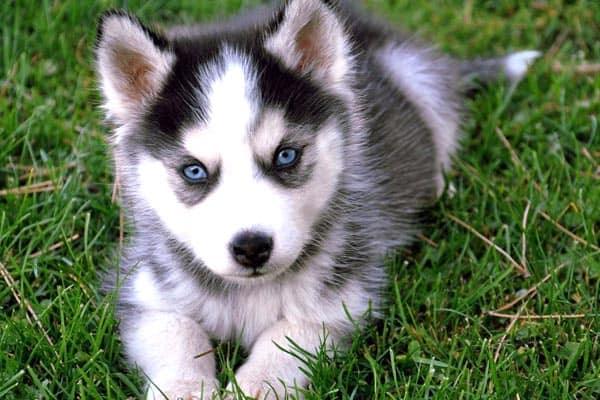
If you are reading this article right now, you may have run across an adorable picture of a Pomsky online or perhaps you are about to welcome a Pomsky into your life.
This is definitely the right moment to learn whether Pomskies are easy to train or not.
In this article, we learn from experienced Pomsky trainers, owners, and breeders about the challenges and rewards of training Pomskies. Are they easy to train? Let’s find out!
Are Pomskies Easy to Train?
Pomskies are not easy to train. They are a demanding dog breed in every way. If you are considering adding a Pomsky to your family, this is very important to know before you make that lifetime commitment.
Pomskies inherit a very unique blend of genetic traits and attributes from the parent dog breeds, the Pomeranian, and the Siberian Husky.
While there is no doubt the mix makes for an incredibly cute puppy, the reality is that your adult Pomsky dog is going to be somewhat stubborn and will need your help to adjust well to life in a family and community.
Watch a Pomsky Puppy Ace Their Training!
In this precious video, an experienced dog trainer teaches a Pomsky puppy some basic commands including sit, stay, and down.
The trainer explains that the Pomsky puppy is learning all of these commands for the first time. She reviews how to effectively use treats, hand signals, and other aids to help the puppy learn as quickly as possible.
Why Are Pomsky Dogs Difficult to Train?
As the Pomsky Owners Association explains, these are the key reasons why the Pomsky hybrid dog breed tends to be difficult to train:
1. Pomskies are extremely energetic
Pomskies get their high energy naturally. Both the Pomeranian and the Siberian Husky come from long breed lines of spitz-type dogs that are born and bred to run and run and run.
While the modern Pomeranian is far too tiny (most weigh just three to six pounds fully grown) to run long distances now, they still have the double-layer coat of the spitz dogs and the high energy level to match.
The modern Siberian Husky is still fully capable of being trained on a harness and will run endlessly if let off-lead in an open unfenced area.
This means your Pomsky is going to get high energy from both gene pools and won’t be able to sit still and pay attention for very long in training without getting distracted and wanting to play or run around.
2. Pomskies are stubborn with strong personalities
The American Kennel Club (AKC) describes the Pomeranian dog breed as a tiny dog with a big dog personality.
In other words, the tiny Pomeranian really doesn’t realize they are small. They act like they are big and imposing and can throw their weight around. This can make the Pomeranian stubborn because they don’t seem to know their own limitations.
While the larger Siberian Husky is known to be friendly and surprisingly approachable (they don’t make very good watchdogs), they are absolutely driven to run, which means they can get distracted very easily by anything that moves.
As the American Kennel Club (AKC) explains, Siberian Huskies are outgoing, friendly, energetic, and often mischievous, which can make keeping their attention a challenge.
As well, the Siberian Husky has a long history working in a dog pack pulling sleds long distances. So they don’t tend to “get” the need to obey some of the basic training commands designed for less energetic companion canines.
This may make the Siberian Husky appear more stubborn than the breed actually is – they just don’t understand why they should “sit” or “stay” when they are so instinctively driven to run and go and move.
With these two breeds for your Pomsky’s parents, you can expect training to challenge you right from the start.
3. Pomskies are nippers
Pomskies are known to nip, bark, jump, dig, chew, and basically do nearly every problem behavior that dog owners don’t want their pet dogs to do.
This comes in part from the Pomsky’s naturally high energy levels and their natural smarts. A bored Pomsky will find something to do, even if it is something you really don’t want them to do.
Pomskies can also be nippy because this is an instinctive drive that is hard-wired into the spitz or snow dog personality traits, as Snowdog Guru explains.
Both the Pomeranian and the Siberian Husky have this trait because both are descended from arctic sled dogs and snow dogs. In addition to pulling sleds and cargo, these dogs have been bred to assist with hunting and tracking.
This is also why Pomeranians and Siberian Huskies tend to have trouble learning to walk on a leash. They want to chase and explore and hunt every small fast-moving thing they see.
The nipping behavior also serves another valuable purpose in pack sled and working dogs like the Siberian Husky and the spitz breeds in general. The nipping is a way that puppies play and dogs communicate with one another.
So it is natural that your Pomsky might nip at you, but it is not desirable and it can make training your Pomsky a very real challenge.
How to Make Training Your Pomsky Easier
These training tips from Pomsky breeders and dog trainers can help you get your training sessions started out on the right foot.
Use only positive training methods with Pomskies
As Brookside Pomskies breeders explain, you only want to use positive, praise-based training with a Pomsky.
These dogs are smart and sensitive and will react harshly if you try to use punishment or negative reinforcement-based training methods.
Praise, treats, pats, and playtime make the best training aids for a Pomsky puppy.
Expect potty training to take longer
Pomskies tend to have more trouble with potty training due to their smaller size as puppies.
The reason is not that your Pomsky doesn’t want to go to the right place. They just have smaller bladders and sometimes can’t hold it as long!
As well, the Pomsky’s tiny digestive and bladder/bowel system is still maturing for the first year of life, which makes “accidents” a daily possibility.
To ease the process, just schedule more frequent potty breaks and make sure to always take your Pomsky out for potty training right after drinking or eating.
Keep training sessions short and focused
Once you know that a Pomsky is always going to have a shorter attention span and a higher energy level than some domestic dogs, you can adjust your training sessions to work with your dog’s temperament.
The Pomsky may not be able to pay attention as long, but this dog breed is very smart. So keep training sessions short and focused.
Only train one command per session and reward your dog lavishly for every “win” in training. Keep training sessions fun and lively and your Pomsky will likely want to participate.
Start training right away and do multiple sessions each day
You definitely don’t want to delay the start of dog training when you are training a Pomsky. Your dog will need your help to learn how to be a productive member of a family and community.
Because your dog does have a short attention span and a small bladder, you should schedule very short, frequent training sessions. Even five minutes of training can be enough to reinforce new commands.
As VetStreet points out, Pomskies need extensive socialization with you and your family, with strange people and with strange animals in order to learn proper behavior.
You want to get your dog started with basic training by the age of 10 weeks old – or whenever you first bring your Pomsky home. If you wait, your Pomsky’s tendency to be stubborn will likely get worse.
Enroll your Pomsky into canine athletics
You definitely want to wait until your Pomsky has received all required and recommended vaccinations and pest control treatments before enrolling your dog in any public classes.
However, once your canine veterinarian has cleared you to do this, you may find it very helpful to get your dog started with canine athletics.
Jumping, running, racing, rally (obedience), and dog show competitions can be fun for you both and off ran excellent, a reliable outlet for your Pomsky’s high energy level.
Safety Notes When Training a Pomsky
Because Pomskies tend to be small, you should never let your Pomsky jump up and down off couches or furniture. There is a risk of breaking a leg or other injuries.
Make sure every family member participates in training your Pomsky so that your dog learns to mind every person and not just one person.
Finally, if you have very young kids or vulnerable pets in your family, you may want to reconsider choosing a Pomsky.
